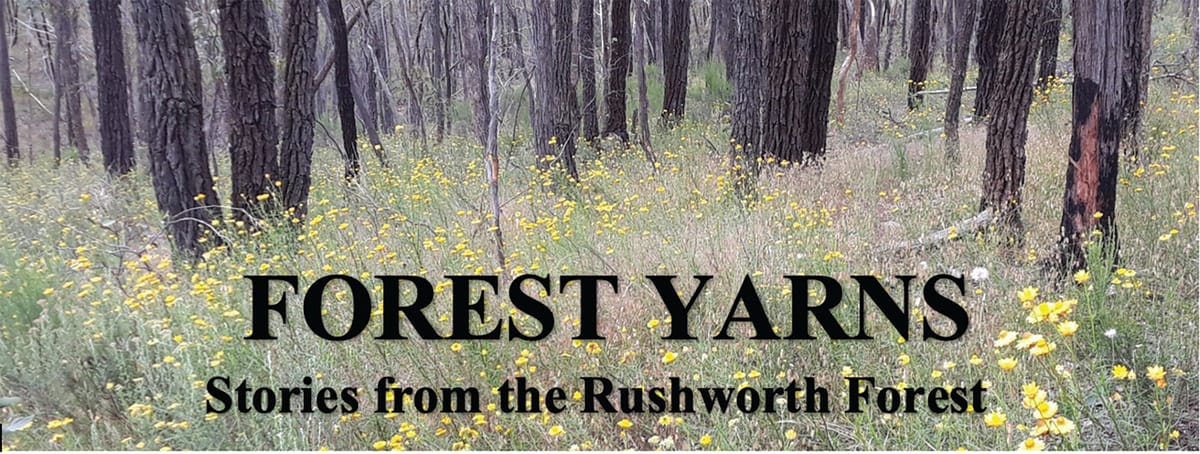Charcoal, eucy oil and honey

Unfortunately, there do not seem to be any records of how much charcoal was produced in the Rushworth forest in the second half of the 19th century. Into the 20th century, as government became more actively involved in the management of forests, more records were kept.
In the 1917 financial year, the Rushworth forest officer (Mr H G White) reported that 6149 bags of charcoal had been produced. Without knowing the exact size of bags used, if you assume they were about 25 kg and there were 40 bags to the ton, you are looking at over 150 tons being produced that year. Charcoal could be produced using the dry timber from any of the main local species of eucalypts – red ironbark, red and yellow gum and grey and yellow box. Logs would be covered with soil so that there was little or no access to the oxygen which would make them burn too fast.
From that point onwards, the local charcoal industry was in steady decline.
Production had virtually stopped by the start of the second world war. Only 40 bags were recorded in the 1938 financial year. This was not because charcoal was no longer needed. Production levels in Victoria were high during the war, when there was demand for it to power motor vehicles at a time when petrol was scarce. It was also used to power industrial facilities like the electricity supply plant at Heathcote.2 This suggests that the supply of suitable logs was exhausted in the local Waranga area and production sites had moved to other areas by the 1940s.
Eucalyptus oil
Eucy oil distillation has been a long-standing industry in the Rushworth forest, continuing to this day courtesy of the Jones family. There have been previous stories published in the Waranga News about the industry, so this particular story will just recap some of the main points.
William Begg introduced the industry to Rushworth in the early 1890s. He had previously lived in Rushworth where he was a successful general merchant in the 1870s and 1880s. He gained licences to cut eucalyptus and distil the oil, with his plant being set up in Parramatta Gully. Eventually Begg sold the business to a distiller from Inglewood before it passed into the hand of the Jones family, who have now been on the site since 1909. 115 years of continuous production, which is quite an achievement!
Production was at its peak around the end of the first world war. The forestry officer reported that 16985 pounds (7704 kg) of eucy oil was registered in the financial year to 30 June 1917. The following year’s production was almost as impressive – 15924 pounds (7223 kg). Thereafter, levels of production varied over the years, but generally were well below those levels. Only in 1919 and 1926 did output again exceed 10,000 pounds (4536 kg) in the period up to the second world war.1
Present day eucalyptus oil production is substantially less than in earlier years. The Jones family still have a licence to cut leaves from various coupes of mallee, including some you can see from the Rushworth-Whroo Road. They also have a licence to occupy the factory site in Parramatta Gully. Unfortunately, it is virtually impossible to get assurances from the relevant government authorities that these arrangements will continue indefinitely to into the future. If ever it comes to the crunch and the Victorian government seeks to terminate the current arrangements, you would hope that the people of Rushworth would fight tooth and nail to preserve this important part of the town’s heritage.
Honey
Unlike other industries that were required to report their output as a basis for paying royalties, it appears that apiarists were only required to take out a licence to operate in the forest. The first year that receipts from apiarists were recorded by the forest officer was 1933, when seven businesses paid for a licence. There was clearly a surge in interest, because in 1936, 38 licences were taken out at a cost of one pound and five shillings each ($2.50 – about $140 in today’s dollars). During the early 1940s, there were still between 20 and 30 licences being taken out each year.1 You would presume that many of these would be used to carry out very small scale operations to provide honey for personal use, and make a few pounds on the side.
References – 1 Public Records Office of Victoria, State Forests Output Books (Rushworth 1916-29 and 1929-42); 2 DSE Brochure (ed. Carolyn Slijkerman 2006 – Heathcote and Rushworth State Forests.
Tony Ford




